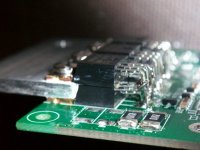AmpAnthony
1 µW
- Joined
- Jun 29, 2020
- Messages
- 4
Hi!
I did research in this forum and others, seems it can be possible to add parallel MOSFET-s to controller, to increase current capability.
I red that capacitances of parallel FET-s can be problem, they could not switch correctly and make short circuit (when + and - FET-s are on at the same time). It helps if we add resistors to each gate (30-100ohm) but this will make them slower to switch.
I have a 500W brushless controller (low cost) which I would like to make more powerful by adding FET-s. I will use NCEP01T13A MOSFET-s. Don`t look at FET-s - connected just for testing right now.
- connected just for testing right now.


Controller seems to already have 100ohm resistor for FET

1. So my question is, what problems can I expect with paralleling MOSFET-s?
2. What size resistors to use?
3. Is correct way to connect parallel MOSFET gate resistors into original gate connection point?
4. Can adding resistance to gate make is so slow that I will have short circuit (- and + turned on same time)?
5. How many parallel MOSFET-s is possible?
Idea:

Let`s not discuss is this acitivity reasonable vs buying more powerful controller, just learning project current shunt will be modified, FET-s will have copper cables for power and heatsinks
current shunt will be modified, FET-s will have copper cables for power and heatsinks
I did research in this forum and others, seems it can be possible to add parallel MOSFET-s to controller, to increase current capability.
I red that capacitances of parallel FET-s can be problem, they could not switch correctly and make short circuit (when + and - FET-s are on at the same time). It helps if we add resistors to each gate (30-100ohm) but this will make them slower to switch.
I have a 500W brushless controller (low cost) which I would like to make more powerful by adding FET-s. I will use NCEP01T13A MOSFET-s. Don`t look at FET-s


Controller seems to already have 100ohm resistor for FET

1. So my question is, what problems can I expect with paralleling MOSFET-s?
2. What size resistors to use?
3. Is correct way to connect parallel MOSFET gate resistors into original gate connection point?
4. Can adding resistance to gate make is so slow that I will have short circuit (- and + turned on same time)?
5. How many parallel MOSFET-s is possible?
Idea:

Let`s not discuss is this acitivity reasonable vs buying more powerful controller, just learning project


